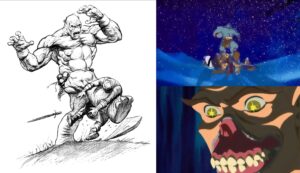I decided to make a little page decided to my Tolkien scholarship. It's not as extensive as my Metroidvania work or work on ludo-Gothic BDSM, but I thought it's still worth having all the same.
Note: This version is copied directly from my website version; the two are identical. The rest of this post is the copy/paste. —Perse
Persephone van der Waard is a leading expert on Metroidvania; re: from her master's, postgrad material, and PhD* in Gothic poetics and ludo-Gothic BDSM. This page specifically highlights her work on Tolkien (the rest of Persephone's portfolio can be found on her 18+ website's About the Author page).
*Re: Volume Zero of her Sex Positivity series, the latter of which which you can read about on its one-page promo; the former has its own book promotion, "The Total Codex."
Persephone's Tolkien Jargon
Here is the neo-jargon Persephone has written that focuses specifically on Tolkien (refer to "Paratextual Documents" for a variety of other important keywords connected to this one):
Tolkien and Cameron's refrains (abridged)
Originally conceived of during my PhD, a refrain is a repeatable exercise that upholds Capitalist Realism, in some shape or form (though generally in videogames, per neoliberal media onwards). As I write in "A Note on Canonical Essentialism" (2024):
execution of conquest involves a map of a location, the latter filled with enemies (e.g., orcs) who must be cleared by human agents or token enforcers, doing so step-by-step, person-by-person, room-by-room to effectively "sweep" the entire area of perceived hostilities. Doing so is meant to achieve one cycle of capital in miniature; i.e., moving money through nature to achieve profit as expressed concentrically on all registers. Likewise, the basic categories of land, sexual biology and ecology manifest in a variety of refrains canonizing Cartesian dualism (and its harmful divisions) through Capitalist Realism. My book pointedly highlights two: Tolkien's and Cameron's [from Volume Zero:
Under Capitalist Realism, Hell is a place that always appears on Earth [or an Earth-like double]—a black fortress threatening state hegemony during the inevitable decay of a colonial body. Its widening state of exception must then be entered by the hero during the liminal hauntology of war as a repeatable, monomythic excursion—a franchise to subdue during military optimism sold as a childhood exercise towards "playing war" in fantastical forms; e.g., Castlevania or Metroid. Conjure a Radcliffean menace inside the Imperial Core, then meet it with American force (source). ...]
(exhibit 1a1a1h2a1 [ibid.]: […] Videogames are war simulators; in them, maps are built not merely to be charted and explored, but conquered through war simulations. The land is an endless site of conquest, war, rape and profit carefully dressed up as "treasure," "liberation" and "adventure," but in truth, brutalizing nature during endless wars of extermination borrowed from the historical and imaginary past as presently intertwined:
-
-
-
- top-left: Tolkien's refrain, "Thror's Map" from The Hobbit, 1937—source: Weta Workshop
- top-right: Thomas Happ's map of Sudra from Axiom Verge, 2015—source: magicofgames
- bottom-left: Team Cherry's map of Hallownest, from Hollow Knight 2017—source: tuppkam1
- bottom-right: Bungie's map of the West from Myth: the Fallen Lords, 1997—source: Ben's Nerdery [...]
-
-
Tolkien's refrain gentrifies war in a fantasy-themed cartography (the map of conquest in novels, movies and games, video or otherwise), which neatly and consistently divide land and occupant between good and bad, human and orc (or spider, demon, ghost, etc). Cameron's refrain, the shooter and the Metroidvania, was first inspired by Robert Heinlein before likewise being injected into popular media as conducting military optimism abroad: insectoid places to go and bomb/shoot into oblivion. Doing so happens while simultaneously popularizing it back home through military urbanism and urban warfare inside the Gothic castle (versus the land around the castle, as Tolkien tends to do; i.e., the open battlefield). There is always an enemy of nature to kill and destroy in ways that fetishize the larger alienating process (source).
Persephone's Tolkien Scholarship
Apart from Metroidvania, Persephone is also an avid Tolkien nerd/critic (from Volume Zero):
[Top-right: My brother's 2001 copy of The Hobbit, which I've had for years and used to cite all of my work on Tolkien, including one of my better* undergraduate essays, "Dragon Sickness: the Problem of Greed" (2015). It was also a book that I read to nurse my broken heart, in college; but segued into my planning to go to college to find love (to have lots of nerd sex)—which eventually happened when I met Constance (my first) at EMU and Zeuhl, at MMU, and promptly had an adventure that did not start or end with them, but introduced me to someone whose ghost, for or worse, would stay with me for the rest of my life. I don't think you can have an adventure without a bit of sex and/or ghosts, by the end of it!
*I wrote "The Problem of Greed" in Craig Dionne's LITR 405 (Shakespeare) course. We had to cross-examine two primary texts with an academic secondary text. I went with Tolkien's The Hobbit, Shakespeare's The Merchant of Venice (1605) and Max Weber's The Protestant Ethic and the Spirit of Capitalism (1904). The essay won me an award from EMU, whereupon the faculty wrote this award letter—to EMU's Distinguished Student in Literature Award—for 2016:
[My award letter from EMU, MA from MMU, and me in 2018 sitting on a copy of Better Off Dead: The Evolution of the Zombie as Post-Human (2011) borrowed from the school library (the photo was taken by my-partner-at-the-time, Zeuhl, for a school project of theirs).]
There was no money involved, but the letter did help me gain entry to MMU (which was a whole ordeal, to say the least; Persephone van der Waard's Quora answer to "How easy is it to get into Manchester Metropolitan University?" 2019) when I went there for my master's degree in English Studies: the Gothic, in 2017. In short, I had an adventure where the things gained is largely open to interpretation: "This is a story of how a Baggins had an adventure, and found [herself] doing and saying things altogether unexpected. [She] may have lost the neighbors' respect, but [she] gained—well, you will see whether [she] gained anything in the end" [source].
A transcription of the letter for EMU's 2016 Distinguished Student in Literature Award (above, left):
The literature program is happy to give the 2016 Distinguished Student in Literature Award to [Persephone] van der Waard. Those of us who have the good fortune of encountering [Persephone] in our classrooms—and for lively conversations in our offices—have come to know [her] as a superb student and voracious reader who pursues knowledge with indefatigable curiosity. Department faculty describe [Persephone] as a "strikingly original" and "capacious" thinker and thoroughly enjoy the outpourings of [her] lively intellect and exceptional intellectual curiosity. It is wonderful, one faculty writes, "to work with a mind so incredib[ly] eager to learn."
[Persephone] excels as an attentive and nuanced reader of literary texts and expert sleuth of textual histories. [She] has an impressive ability to synthesize disparate material, making surprising connections between wide-ranging ideas and experiences. [Persephone] as one faculty remarks, "is not afraid to take tangents or draw comparisons that at first look random but end up opening up a new vista for reflection." We have been equally delighted by the fine scholarly essays and research papers [Persephone] has produced in our classes. Faculty describe [her] writings as "eloquent, carefully organized," "astonishingly adroit," comparing, for instance, Tolkien's image of greed with Shakespeare's reflection on Shylock's materialism, via a close reading of Max Weber's idea of rationality and modern notions of money as status.
We anticipate a bright future for [Persephone] and wish [her] the best for [her] future scholarly exploits. [Persephone] is most deserving of the Distinguished Student in Literature Award, and we are grateful to have [her] as a student in our department. We'll be reading [Persephone's] writing one day, and probably teaching it.
Further Reading by Persephone (on Tolkien)
Tolkien appears all throughout my book series, but here are some key essays I've written about him in the past (the ones from Volume Zero and Volume One are only available on my website; i.e., by downloading the PDFs that contain them):
- Re, "Dragon Sickness: the Problem of Greed" (2015): This paper compares and contrasts notions of rarefied greed in Tolkien's novel, The Hobbit, compared alongside Shakespeare's play, The Merchant of Venice, when taking into consideration the idea of wealth as defined by Max Weber in his own work, The Protestant Ethic and the Spirit of Capitalism.
- "On Twin Trees; or, 'Taking the Trees Back during Oppositional Praxis': the Superstructure and Base; Tolkien vs Milton; and Our Manifesto Tree" (from Volume Zero, 2023): This piece gives the manifesto tree, which lists our series' praxial equations and coordinates relative to the holistic study and camping of canon's singular interpretations (and subsequent policing) under Capitalism. Supplies several equations, followed by two exhibits on the Base/Superstructure and Tolkien vs Milton insofar as "trees" are concerned. Then, it considers the twin "trees" of Capitalism—the Base and the Structure (re: Marx)—as things to "corrupt" and reclaim away from Capitalism; i.e., when developing towards Gothic (gay-anarcho) Communism: our manifesto tree of oppositional praxis.
- "Camping Tolkien's Refrain using Metroidvania, or the Map is a Lie: the Quest for Power inside Cameron's Closed Space (and other shooters)" (from Volume Zero): This section of my PhD (about a quarter of its overall length) explores the interrogation of power in relation to Gothic space (castles) but especially in videogames (shooters, High Fantasy and Metroidvania). It also interrogates Tolkien's [cartographic] refrain [the treasure map] through the conceptualization of Cameron's refrain (the shooter); i.e., not through the FPS, but the Metroidvania—a particular kind of third-person shooter (TPS)/castle space that (along with the monsters inside) can be camped, but also achieves immense catharsis through honest and profound theatrical evocations of psychosexual trauma: a palliative Numinous and fairly negotiated (thus sex-positive) ludo-Gothic BDSM achieved by remaking Gothic castles, thus negotiating the unequal power lurking inside an iconoclastic castle or castle-like space.
- "An Uphill Battle, part two: Concerning Rings, BDSM and Vampires; or the State's False Gifts, Power Exchange, and Crumbling Homesteads Told through Tolkien's Nature-Themed Stories" (from Volume One, 2023): This essay examines rings within the Gothic mode as famous symbols of power and power exchange; i.e., through the vampire legend as used by Tolkien. We'll examine power as Tolkien expressed it in relation to nature as something to conquer by proxy—an invented other. In short, Tolkien relied on the vampire legend—but also Gothic castles, BDSM language and harmful arrangements of unequal power (rings and collars)—to dominate nature and those within it.
- "Goblins, Anti-Semitism and Monster-Fucking (feat. Tolkien's orcs and goblins, acid Communism, and SpongeBob SquarePants)" (from the Demon Module, 2024): My final essay on Tolkien examines the vengeful, monstrous-feminine qualities of blood libel per goblins; i.e., their being "of nature" in ways that can be policed or avenged by theatrical agents waxing demonic poetic while playing with darkness visible. Explores these dualities first in Tolkien canonizing evil labor policed by good (orcs and goblins [vengeful-Jewish-coded slaves and whores] vs humans), followed by our own work and others camping him: through such "monster-fucking" play as highly chaotic/acid-Communist (e.g., Ween and SpongeBob).
- "'A Lesson in Humility'; or, Gay Zombie Caesar (and His Token Servants) When the Boomerang Comes Back Around (feat. Myth: the Fallen Lords)" (from the Undead Module, 2024): Explores queer aspects to the undead warlord/Zombie Caesar in Myth: the Fallen Lords (and his token, anti-Semitic servant, in Myth II: Soulblighter); i.e., by diving into the game's DARVO-style, empire apologia, effectively describing how empires-in-decay endlessly recolonize themselves in between monomyth fiction and non-fiction—not just with the raw mechanics of colonialism (chiefly armed conflict) stuck in a self-destructive loop, but spearheaded by past historical figures who, as current genocides committed by the good guys are abjected, return as fascist bogeymen to colonize empire from the outside in. Includes examinations of Tolkien as the palimpsest for Bungie's landmark title.
- "Policing the Whore; or, Topping from Below to Rise from the Ashes (feat. Hollow Knight and The Hobbit)": Articulates Aguirre and Bakhtin's ideas per my evolution of ludo-Gothic BDSM after my master's thesis and into my graduate work, then considers the Promethean Quest as something that presents the whore as normally hunted by police forces, only to escape their subjugation and imprisonment by acting out her own rape; i.e., as Hollow Knight‘s final boss, the Radiance, does when faced with tokenized state proponents (the example I give being Tolkien's treasonous dwarves from The Hobbit and their own dubious search for homeland, mid-assimilation; re: by killing Smaug the dragon to assimilate).
***
Persephone van der Waard is the author of the multi-volume, non-profit book series, Sex Positivity—its art director, sole invigilator, illustrator and primary editor (the other co-writer/co-editor being Bay Ryan). Persephone has her independent PhD in Gothic poetics and ludo-Gothic BDSM (focusing on partially on Metroidvania), and is a MtF trans woman, anti-fascist, atheist/Satanist, poly/pan kinkster, erotic artist/pornographer and anarcho-Communist with two partners. Including multiple playmates/friends and collaborators, Persephone and her many muses work/play together on Sex Positivity and on her artwork at large as a sex-positive force. That being said, she still occasionally writes reviews, Gothic analyses, and interviews for fun on her old blog (and makes YouTube videos talking about politics). To learn more about Persephone's academic/activist work and larger portfolio, go to her About the Author page. To purchase illustrated or written material from Persephone (thus support the work she does), please refer to her commissions page for more information. Any money Persephone earns through commissions goes towards helping sex workers through the Sex Positivity project; i.e., by paying costs and funding shoots, therefore raising awareness. Likewise, Persephone accepts donations for the project, which you can send directly to her PayPal, Ko-Fi, Patreon or CashApp. Every bit helps!






Comments
Post a Comment